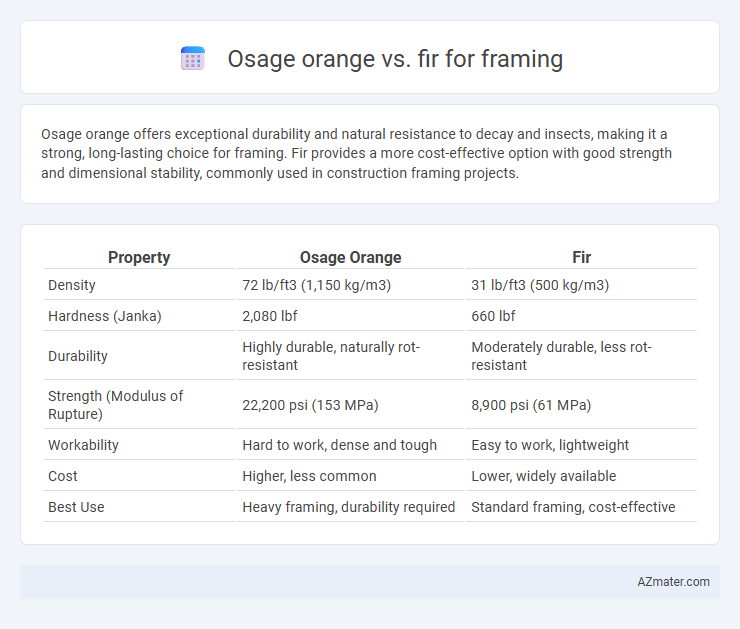Osage orange offers exceptional durability and natural resistance to decay and insects, making it a strong, long-lasting choice for framing. Fir provides a more cost-effective option with good strength and dimensional stability, commonly used in construction framing projects.
Table of Comparison
| Property | Osage Orange | Fir |
|---|---|---|
| Density | 72 lb/ft3 (1,150 kg/m3) | 31 lb/ft3 (500 kg/m3) |
| Hardness (Janka) | 2,080 lbf | 660 lbf |
| Durability | Highly durable, naturally rot-resistant | Moderately durable, less rot-resistant |
| Strength (Modulus of Rupture) | 22,200 psi (153 MPa) | 8,900 psi (61 MPa) |
| Workability | Hard to work, dense and tough | Easy to work, lightweight |
| Cost | Higher, less common | Lower, widely available |
| Best Use | Heavy framing, durability required | Standard framing, cost-effective |
Introduction to Osage Orange and Fir Wood for Framing
Osage orange is a dense, durable hardwood prized for its strength and natural resistance to decay, making it an excellent choice for framing in environments requiring longevity and toughness. Fir wood, known for its straight grain and moderate strength, offers a lighter, more workable option widely used in construction for framing due to its availability and cost-effectiveness. Both woods provide key structural benefits, with Osage orange excelling in durability and Fir favored for ease of use and versatility in framing applications.
Botanical Overview: Osage Orange vs Fir
Osage orange (Maclura pomifera) is a hardwood native to the south-central United States, known for its dense, durable timber and natural resistance to decay and insects, making it suitable for heavy-duty framing applications. Fir, particularly Douglas fir (Pseudotsuga menziesii), is a softwood widely used in construction due to its strength-to-weight ratio, straight grain, and ease of handling, commonly sourced from the Pacific Northwest. While Osage orange offers superior hardness and longevity, fir provides more consistent structural performance and is preferred for standard framing due to its availability and cost-efficiency.
Wood Strength and Structural Properties
Osage orange wood exhibits exceptional strength and durability, making it highly resistant to compression and bending forces, which are critical for framing applications requiring long-lasting structural integrity. Fir, particularly Douglas fir, offers a balanced combination of high strength-to-weight ratio and workability, allowing for efficient handling and reliable performance in load-bearing frames. While Osage orange provides superior hardness and natural resistance to decay, fir is more commonly used in framing due to its availability, cost-effectiveness, and consistent structural properties.
Durability and Resistance to Decay
Osage orange wood is exceptionally durable with a natural resistance to decay and insects, making it ideal for heavy-duty framing that demands longevity and strength. Fir, while commonly used in construction framing, offers moderate durability and is more susceptible to moisture-related decay without proper treatment. The superior rot resistance of Osage orange ensures longer structural integrity in outdoor or high-moisture environments compared to fir.
Workability and Ease of Use
Osage orange is dense and hard, making it difficult to cut and shape, but it offers excellent strength and durability for framing. Fir is lighter and softer, providing superior workability with easier nailing, sawing, and fastening, ideal for quick framing projects. Fir's uniform grain reduces tool wear, while Osage orange requires specialized tools to manage its toughness efficiently.
Cost Comparison: Osage Orange vs Fir
Osage orange wood is significantly more expensive per board foot than fir, with prices often double due to its density and durability. Fir, commonly used in framing, offers a cost-effective option averaging $2 to $3 per board foot, while Osage orange can range from $5 to $8. The higher initial investment for Osage orange is offset by its superior strength and resistance, potentially reducing long-term maintenance costs.
Availability and Sourcing
Osage orange is less commonly available than fir, with sourcing primarily from regions in the central United States, making procurement more specialized and potentially costly. Fir, especially Douglas fir, is widely available across North America with robust commercial supply chains supporting large-scale framing projects. The plentiful supply and consistent quality of fir lumber result in easier sourcing and often lower prices compared to the more niche market of Osage orange.
Environmental Impact and Sustainability
Osage orange offers exceptional durability and natural pest resistance, reducing the need for chemical treatments and lowering environmental impact in framing applications. Fir, commonly used in construction, is a fast-growing softwood that supports sustainable forestry practices but may require preservatives to enhance longevity. Choosing Osage orange promotes longer-lasting structures with less maintenance, while fir provides a more renewable resource with established sustainable harvesting methods.
Suitability for Different Framing Applications
Osage orange is highly valued for heavy-duty framing due to its exceptional strength, durability, and natural resistance to decay and insects, making it ideal for outdoor or load-bearing structures. Fir, particularly Douglas fir, is preferred for conventional framing applications because of its straight grain, ease of workability, and consistent dimensional stability, which supports faster construction and reliable structural performance. For projects requiring long-lasting, robust framing under harsh conditions, Osage orange outperforms fir, while fir is better suited for standard residential or commercial framing needs with moderate load requirements.
Conclusion: Choosing the Best Wood for Framing
Osage orange offers exceptional strength and resistance to decay, making it a durable choice for framing in demanding environments. Fir, widely acclaimed for its straight grain and ease of handling, provides excellent structural stability and cost-efficiency for standard construction projects. Choosing between Osage orange and Fir depends on balancing the need for long-term durability against budget and workability considerations.

Infographic: Osage orange vs Fir for Framing
 azmater.com
azmater.com